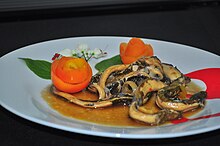 Linarang na bakasi, made with little morays | |
| Alternative names | nilarang, larang, gilarang |
|---|---|
| Course | Main course |
| Place of origin | Philippines |
| Region or state | Central Visayas |
| Serving temperature | Hot |
| Main ingredients | fish, garlic, tomato, red onion, fermented black beans, unripe mangoes or bilimbi, chilis, coconut milk |
Linarang, also known as larang or nilarang, is a Filipino fish stew originating from the Central Visayas islands. It is made with fish in a spicy and sour coconut milk-based broth with garlic, red onions, tomatoes, fermented black beans (tausi), chilis, and sour fruits. [1]
